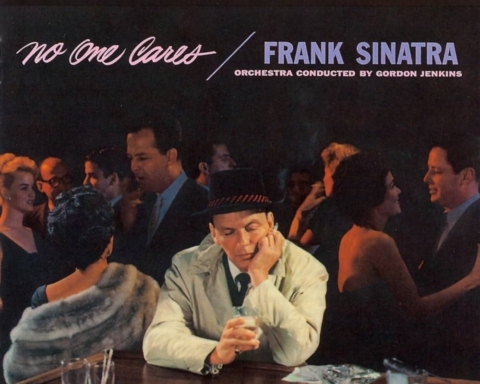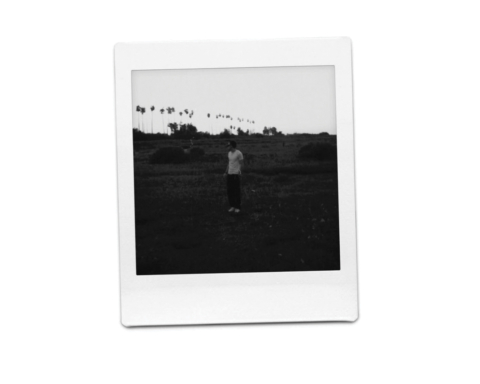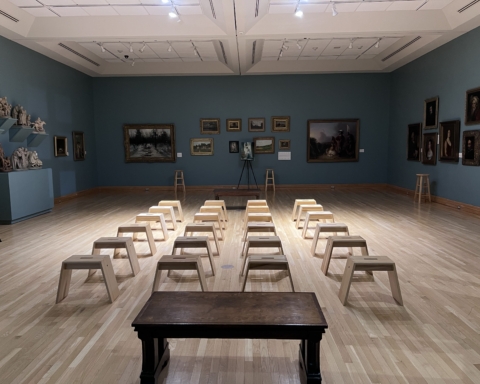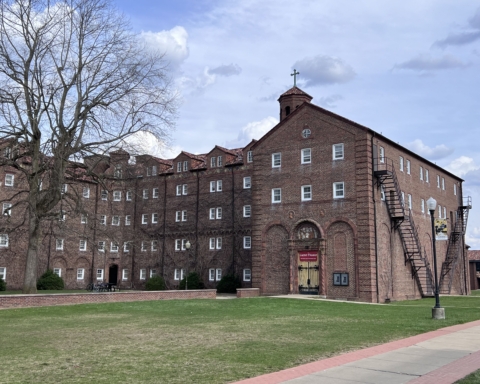By Samantha Berkhead
News Editor
Visit the Bogside region of the city of Derry in Northern Ireland and you’ll find art scaling the walls.
Twelve 30-foot-tall murals in subdued colors depict imagery from the Troubles, Northern Ireland’s decades-long sectarian conflict. This “People’s Gallery” covers the sides of buildings as a means of commemorating the devastation that has happened and a symbol of moving into the future.
The murals, as well as the three men who have painted them for the last 12 years, have grabbed the attention of people around the world.
Today, the Bogside Artists — Tom Kelly, his brother William and their lifelong friend Kevin Hasson — will complete another mural in the San Damiano Room of Francis Hall to leave their mark on St. Bonaventure.
The artists, who worked with students in the department of visual and performing arts on the mural, created the work with the same ideologies in mind as their previous murals. For them, each stroke of paint represents a step toward reconciliation between individuals and groups without bitterness.
“The images that we created are purely our own lives,” Hasson said. “Not only our own lives, but the lives of the people in our community where we come from. We were 11 years old when this war began in 1969; that’s almost 40 years. The conflict of Northern Ireland was our life. We have had family members killed — my 14-year-old cousin was the first child to be shot dead on our streets in Derry City at the beginning of the conflict when we weren’t even accustomed to death on our streets.”
Moving on from the Troubles requires more than ending the guerilla fighting and Protestant-Catholic discrimination. Many Northern Irish citizens have turned to alcoholism and drug addiction to dull their pain, Hasson said, and many in the country still have little pride in their identity. Despite the pain and scars the Troubles left behind, the Kellys and Hasson continue to speak openly about the conflict they lived through as a means of healing and communicating.
“I believe it was William Shakespeare who said, ‘He who steals my purse steals trash, but he who slanders my name makes me poor indeed,’” Tom said. “They’re pretty good words for the Irish, because a lot of what we do in our work and what we try to convey and instill in the community and its children is self-esteem and self-worth as opposed to self-loathing and self-hatred. When you’re ostracized, when you’re oppressed, when you’re caged in, all things begin to break down, including your own sense of self.”
For the Bogside Artists, reminding the people of their homeland of their individual dignity and self-worth in the wake of the Troubles has become one of their primary goals. Tom in particular started working with younger children in Northern Ireland, teaching art as a means of self-expression in workshops that he, William and Hasson continue to do. The workshops, William said, are highly unique to the reconciliation process in Northern Ireland.
“We remind our children that we are an articulate and intelligent people, not the butt of many a joke, not the ‘muck savages of Europe,’ according to the propaganda of years gone by,” Tom said. “We are the people of James Joyce, Samuel Beckett, Bernard Shaw, Oscar Wilde. When it comes to music, we have the Cranberries and U2. When it comes to dancing, we have Riverdance — it’s taken the world by storm. We try to instill that in our youth, because what they’ve been robbed of in this conflict is their self-worth and their self-esteem as they watch their parents and their brothers and sisters being dragged off without jury, without trial, without evidence into prisons. It’s not about inciting young people to seek revenge. What we’re saying in our art is that you are a human being of value. We tell our people, ‘Go that way. Be your own person. Make your own decisions. Do not be swayed in your emotions by the rhetoric of political people.’ That’s our message to the kids: listen to your own spirit, listen to your own heart and go your own way.”
William, who has multiple degrees in art, said painting became a basic part of his life and a reminder of his own humanity and the humanity of others.
“Art is what made us human beings,” he said. “Science didn’t make us human beings. Science gave us power to destroy one another, but that doesn’t make you a human being. Literature and music and painting, that’s what’s made us human. Putting blind faith in technology is almost anti-human at this stage.”
For all three of the artists, risks came with making the murals. They received a death threat from a paramilitary group and multiple threats from the British army stating they could be shot down from the scaffolds from which they painted.
William said the danger of creating murals in Northern Ireland has subsided for the most part.
“(The Troubles are) underground now but could spark up again,” he said. “It’s volatile, but it’ll never break out in full-scale conflict again.”
Tom said he sees connections between the Bogside Artists’ focus on resolving pains within their own community and the sense of community service that permeates St. Bonaventure.
“I think it’s important that a university of this magnitude, which I’m sure is a big part of the surrounding district and community, does have a very strong relationship with the rest of the community that are not students,” he said. “In a conflict area, you’re going to find people who want to belong to something, they want to have some significance. I think Christianity should provide that, and it should be challenging.”
After leaving St. Bonaventure, the Bogside Artists will continue to travel to colleges and universities around the country. Later this year, they will complete a mural in Maribor, Slovenia, which will be unveiled by the Dalai Lama.
They may have gone around the world with their message, but the three artists still try to stay humble.
“We knew we weren’t going to change the world, we knew we weren’t going to change our society, but at least we were willing to give it a shot,”





